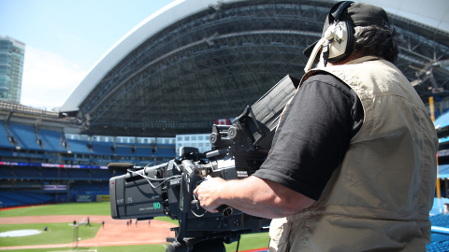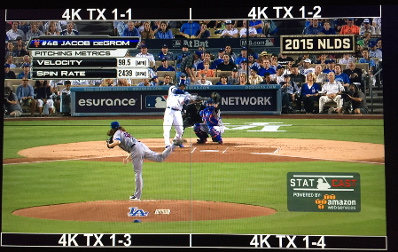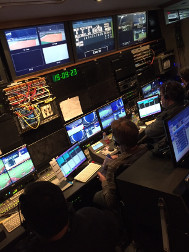MLB Pushes Ahead With 4K Broadcasts
TORONTO—In late April, DirecTV began broadcasting MLB Network Showcase baseball games in 4K, available to DirecTV Premier and Ultimate subscribers equipped with 4K set-top boxes. Simultaneously, Toronto’s Dome Productions has been shooting Blue Jays’ home games in 4K since April 8. Dome’s 4K feed is being distributed nationwide on Rogers Cable’s two Sportsnet 4K channels channels via satellite and DSL.

Dome Productions uses Sony HDC-4300 cameras to cover the Blue Jays in 4K.
To the casual viewer, these two MLB 4K broadcast streams would seem to indicate that seamless 4K live production has arrived. However, the truth is a bit more complicated and—from a real-life engineering perspective—more impressive.
MLB’S 4K ADVENTURE
When it comes to getting Major League Baseball on 4K, DirecTV “made it happen,” according to Susan Stone, senior vice president of operations & engineering for the MLB Network. “They are the ones who partnered with us to take this leap.”
DirecTV urged MLB Network to go 4K because “we are trying to find as much 4K content as we can for our viewers, and sports will be the force that will drive 4K for us,” said John Ward, senior vice president of content operations for DirecTV. “This is why we have modified our satellite transponder allocations to carry 4K signals, and rolled out 4K set-top boxes to our Premier/Ultimate subscribers.”
To produce its Showcase games in 4K, MLB Network uses Game Creek Video’s RiverHawk A&B mobile production units, which have been modified to support 4K production. “Game Creek Video purchased 10 Sony HDC-4300 cameras, which shoot in 4K and can output both 4K and 1080p video feeds,” said Stone. “RiverHawk also has a Grass Valley Systems’ Kayenne K-Frame switcher, which combines four 1080p channels to create the 4K image.” (A single 4K video channel requires 12 Gbps of bandwidth, while a single 1080p channel uses 3 Gbps. Combine four 1080p channels electronically, and you get a single 4K channel.)
Get the TV Tech Newsletter
The professional video industry's #1 source for news, trends and product and tech information. Sign up below.
The rest of RiverHawk’s production equipment has been left in 1080p; including its roster of EVS instant replay systems and Evertz EQX HD video signal routers. “Replay and graphics are produced in 1080p, and then upconverted to 4K,” Stone said. “Doing replay in 4K would require us to have as many as 20 EVS servers; forcing us to have a C unit at a time when parking space is already in short supply at Major League Baseball ballparks. It wouldn’t be practical.”

MLB Networks’ Statcast feature compares a pitcher’s play year over year.
The 12 Gbps 4K output from RiverHawk is sent via AT&T Broadcast Video’s fiber-optic network to DirecTV’s Broadcast Center in Los Angeles, where it is uplinked to the DirecTV-14 satellite for distribution to DirecTV 4K subscribers. Meanwhile, MLB Network takes the 4K feed and downconverts it to 720p, for distribution to the network’s HD audience.
DOME’S 4K APPROACH
Dome Productions also uses Sony HDC-4300s and a Grass Valley Kayenne K-Frame switcher for its at-home Blue Jays baseball coverage. “MLB is just part of what we cover in 4K; we also do NBA and NHL games for our co-owners, Bell Media and Rogers Communications,” said Mary-Ellen Carlyle, senior vice president/GM for Dome Productions. The 4K feed is sent by fiber directly to Sportsnet's 4K channels.
Like MLB Network, Dome Productions upconverts its graphics and other HD sources to 4K, however, its replay servers run in 4K mode, which requires more server stations on the Blue Jays home games. “We produce a single 4K production and then provide a downconvert path for HD 1080i program delivery,” said Mike Johnson, Dome Productions’ director of engineering. For the Blue Jays games, Dome uses its Trillium truck which it recently revamped for 4K. “Our other 4K production unit used for NHL and NBA coverage consisted of two trailers including the ‘Shadow 4K’ production unit that paralleled the main HD production and they shared resources.”
This approach is temporary, Carlyle noted. “Right now, we are building a new production mobile unit called ‘Pioneer’ that will be capable of handling both 4K and 1080p,” she said, adding that it’s expected to enter service in July.
SURPRISINGLY LITTLE GRIEF
Both MLB Network and Dome Productions report that offering 4K video has given them less grief than expected. “Because the aspect ratio is the same as 1080p, working in 4K isn’t as big a leap as moving from SD to HD was,” said Stone. “We do occasionally run into issues when it comes to connecting our cameras. Because the 4300s require fiber connections, we have to run our own cables in ballparks that don’t have sufficient fiber installed. That can be a challenge given our one-day set/shoot/strike approach to covering games.”

Inside the Trillium replay room
The Blue Jays’ Rogers Centre doesn’t have this issue. Three years after buying the stadium in 2005, Rogers replaced all of the Triax cables with SMPTE fiber and single strand single mode fiber throughout the stadium, according to Johnson.
That said, 4K still poses an issue for Dome Productions’ Trillium mobile, specifically when it comes to displaying the full 12G video on the monitor wall. To show the picture in full resolution, the 12G signal is divided into four 3G feeds that are shared across four HD 1080p monitors using Sequential Quad Division (SQD) mode. “In this mode you consume four of everything to pass the full frame 4K image,” said Johnson. “The picture you have is showing the Tx outbound of the four separate feeds that make up the 4K picture.”
A further 4K production challenge is looming on the horizon; namely adding HDR (high dynamic range) color/brightness contrast to MLB Network/Dome Productions’ 4K MLB broadcasts. With both productions still shaking out 4K, adding HDR isn’t yet on their schedules, despite Rogers Communications announcement last fall that they would broadcast the games in HDR starting with the 2016 season, (the cable provider has abandoned such plans for the time being due to a lack of standards, according to a report on wifihifi.ca). However, Carlyle has no doubt that HDR will come. “HDR is really the added-value to 4K,” she said. “When we can add HDR to our broadcasts—and we will—viewers will really see the difference between 4K and HDTV.”
James Careless is an award-winning journalist who has written for TV Technology since the 1990s. He has covered HDTV from the days of the six competing HDTV formats that led to the 1993 Grand Alliance, and onwards through ATSC 3.0 and OTT. He also writes for Radio World, along with other publications in aerospace, defense, public safety, streaming media, plus the amusement park industry for something different.

